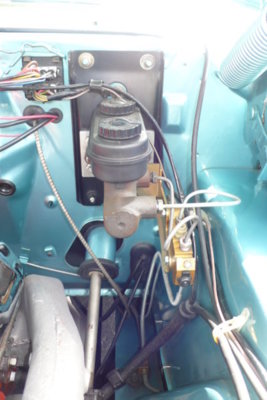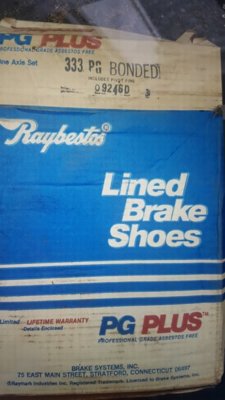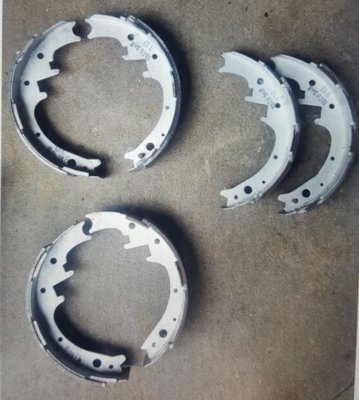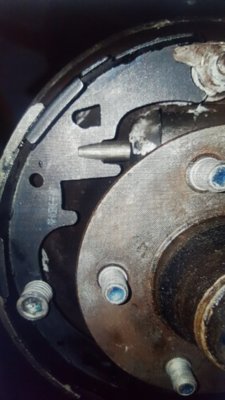Dave145
Well-Known Member
Hello all,
Been awhile since I've been on here! As some of you may remember, I have a '64 Polara that was pretty much a basket case when I got it. Most of the big issues have been worked out for now, but the one I'm having a hell of a time figuring out is the brakes.
Here's the scoop. It's got manual four wheel drum brakes. The master cylinder has been converted from the original single pot style to the dual chamber style. Every part is brand new. The issue is, the car doesn't stop for crap. I'm not saying it takes 500 feet to go from 80-0 mph. I'm saying it takes 5 miles to come to a stop. The pedal is firm as rock, but seems to "grab" low (about mid travel). Here's what's been done so far:
- As stated before, new master(s). Initially I tried a MC from a '76 Dart that also has four wheel manual drum brakes. Pedal grabbed low. Currently have a master on it from a late 60's Monaco or Charger on it. No change. This swap was done to test and see if different bore sizes (15/16" vs 1") would affect it. Both masters feel identical in the car.
- New brake lines front to rear. Line off front of resivoir goes straight to the rear brakes. Line off the rear resivoir goes to a junction block that splits to go to the front brakes. All brake lines on the car are 3/16" diameter.
- New wheel cylinders, shoes and hardware (including adjusters!) at all four corners. New drums in the back. Front drums were turned so there's no ridges in them. Shoes are oriented properly withing the drums as well. All brakes have been adjusted up to the point they *just* touch the drums and lightly drag while rotating. For shits and grins I have also run the shoes tight up to the drums and pressed the pedal. You guessed it, no change.
- I have bled the brakes three or four times at least. I always start by gravity bleeding them, then doing the two man bleeding procedure. The fluid streams at the rear of the car aren't as strong as I'd expect them to be (weaker than the front anyway). They just kind of dribble or lightly squirt when the bleeder is cracked. I am running new DOT3 fluid.
- I have tried lengthening and shortening the brake push rod to see if that changes anything, but it doesn't.
The pedal *grabs* at about half stroke. At that point it becomes solid as a rock or dang close. When driving down the road if I slam on the brakes it will not lock any of the wheels, no matter what speed I'm at. Even on gravel, it will not lock the wheels up. When the car does finally stop, it stops surpringly straight about 75% of the time.
I'm not new to Mopars or drum brakes at all. My first Mopar ('76 Dart) had four wheel manual drum brakes. That pedal was high and very firm. That car had no problem stopping at all! I also had a '72 D150 with four wheel power drum brakes. It also stopped pretty well.
So I'm a bit stumped here. Do I need a proportioning valve? A large parachute? A different master? I'm out of ideas!
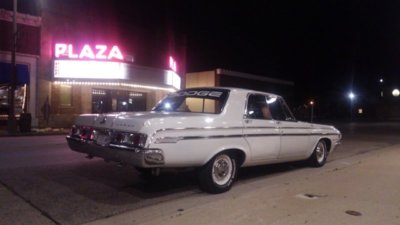
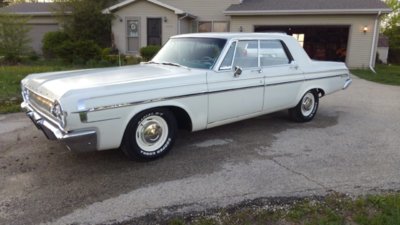
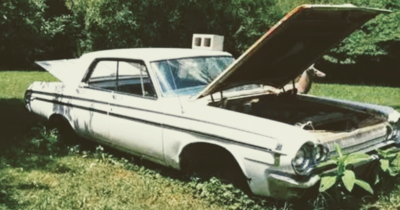
Been awhile since I've been on here! As some of you may remember, I have a '64 Polara that was pretty much a basket case when I got it. Most of the big issues have been worked out for now, but the one I'm having a hell of a time figuring out is the brakes.
Here's the scoop. It's got manual four wheel drum brakes. The master cylinder has been converted from the original single pot style to the dual chamber style. Every part is brand new. The issue is, the car doesn't stop for crap. I'm not saying it takes 500 feet to go from 80-0 mph. I'm saying it takes 5 miles to come to a stop. The pedal is firm as rock, but seems to "grab" low (about mid travel). Here's what's been done so far:
- As stated before, new master(s). Initially I tried a MC from a '76 Dart that also has four wheel manual drum brakes. Pedal grabbed low. Currently have a master on it from a late 60's Monaco or Charger on it. No change. This swap was done to test and see if different bore sizes (15/16" vs 1") would affect it. Both masters feel identical in the car.
- New brake lines front to rear. Line off front of resivoir goes straight to the rear brakes. Line off the rear resivoir goes to a junction block that splits to go to the front brakes. All brake lines on the car are 3/16" diameter.
- New wheel cylinders, shoes and hardware (including adjusters!) at all four corners. New drums in the back. Front drums were turned so there's no ridges in them. Shoes are oriented properly withing the drums as well. All brakes have been adjusted up to the point they *just* touch the drums and lightly drag while rotating. For shits and grins I have also run the shoes tight up to the drums and pressed the pedal. You guessed it, no change.
- I have bled the brakes three or four times at least. I always start by gravity bleeding them, then doing the two man bleeding procedure. The fluid streams at the rear of the car aren't as strong as I'd expect them to be (weaker than the front anyway). They just kind of dribble or lightly squirt when the bleeder is cracked. I am running new DOT3 fluid.
- I have tried lengthening and shortening the brake push rod to see if that changes anything, but it doesn't.
The pedal *grabs* at about half stroke. At that point it becomes solid as a rock or dang close. When driving down the road if I slam on the brakes it will not lock any of the wheels, no matter what speed I'm at. Even on gravel, it will not lock the wheels up. When the car does finally stop, it stops surpringly straight about 75% of the time.
I'm not new to Mopars or drum brakes at all. My first Mopar ('76 Dart) had four wheel manual drum brakes. That pedal was high and very firm. That car had no problem stopping at all! I also had a '72 D150 with four wheel power drum brakes. It also stopped pretty well.
So I'm a bit stumped here. Do I need a proportioning valve? A large parachute? A different master? I'm out of ideas!




